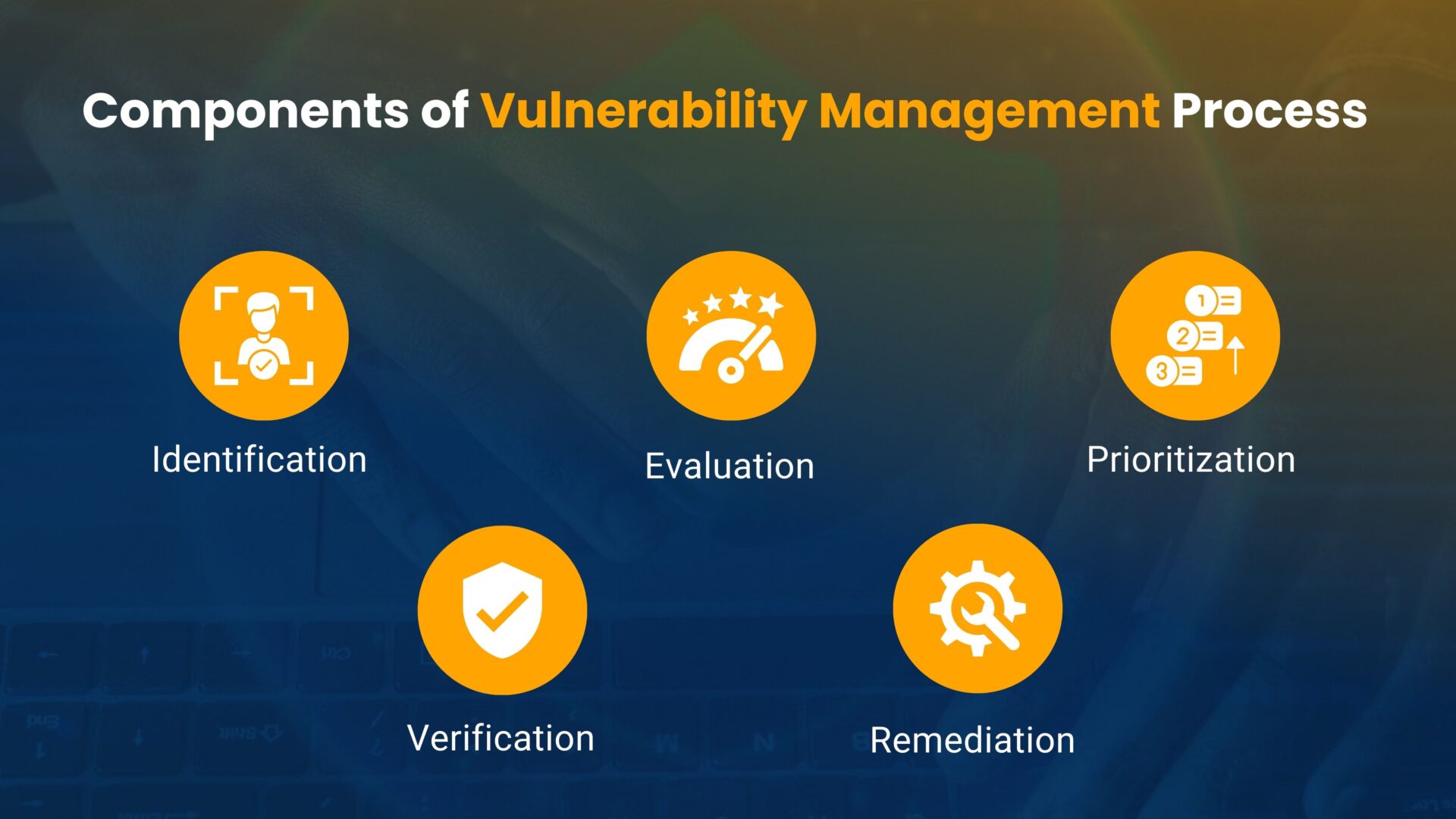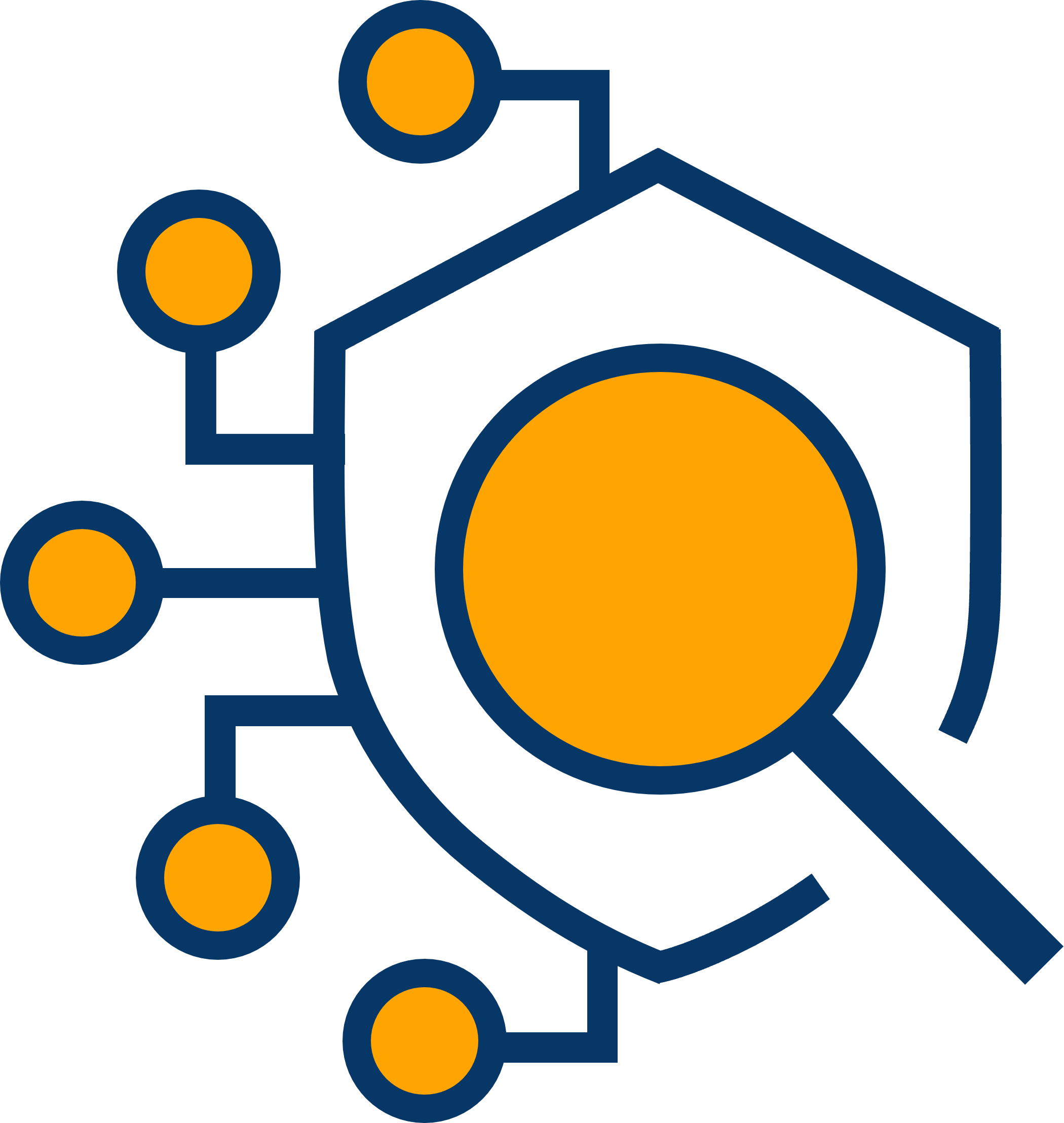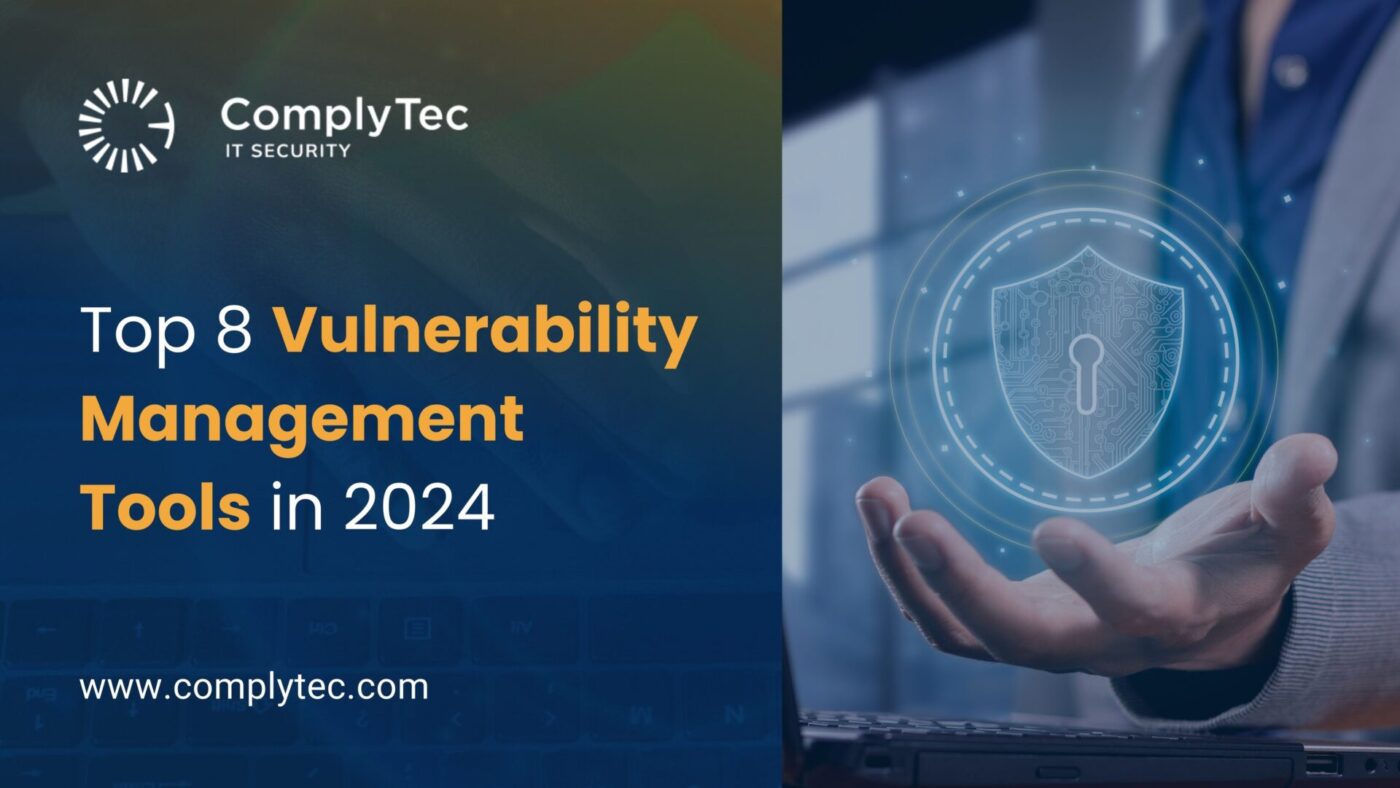It is no surprise that in a data-driven world like ours, we generate about 2.5 quintillion bytes of data every day! (Source: Domo) Organizations contribute the most to generating and storing such large volumes of data. When an organization stores such large amounts of data, it becomes imperative to monitor the organizational-wide data to avoid any external threats and vulnerabilities.
Recent studies have revealed that 84% of organizations have high-risk vulnerabilities (Source: PTSecurity), and they spend an average of 130 hours per week monitoring, tracking, and remediating them (Source: Ponemon Institute). These statistics show that organizations must strengthen their security strategies to identify vulnerabilities and threats before they cause reputational damage.
Organizations must invest in the best vulnerability management tools to effectively recognize and remediate existing vulnerabilities. In this blog, we will delve into what vulnerability management is and why vulnerability management tools are crucial for your organization. Once we have laid the foundation, we will explore the components of vulnerability management software and list the top 8 vulnerability management tools in 2024, as verified and referenced by Gartner.
What is Vulnerability Management?
A common question those unfamiliar with cybersecurity strategies ask is, what is vulnerability management? Vulnerability management refers to continuously identifying, prioritizing, mitigating, and remediating security gaps within software, networks, and systems. It is a systematic approach to proactively eliminate any liability or risk within the organization from being exploited by an unauthorized user or a hacker. Using vulnerability management software or tools, your organization can monitor and safeguard its liabilities. Let us explore the components of vulnerability management tools.
Components of Vulnerability Management Process

Vulnerability management tools are designed to assist organizations in identifying, evaluating, and remediating vulnerabilities in their systems and networks. Each step of the vulnerability management process is essential for creating a secure data environment. Here are the components of top vulnerability management tools:
Identification
The first step of the vulnerability management process is identifying vulnerabilities within your organization’s systems and networks. Naturally, the first component of a vulnerability management tool is scanning your data environments to identify any existing vulnerabilities. The scan also helps your organization identify all assets connected to a specific network, including devices, applications, databases, etc. Some top vulnerability management tools also have built-in features to detect any new potential vulnerabilities within your organization.
Evaluation
Once your organization has detected its vulnerabilities, the next step is to evaluate and assess their severity and impact. The evaluation component involves analyzing the nature and characteristics of the vulnerability to determine the potential risks associated with it. Each vulnerability is assigned a severity score based on its risks and severity.
Prioritization
The third step of the vulnerability management process is to prioritize vulnerabilities based on their severity scores and impact. Not all vulnerabilities need your organization’s immediate attention. The ones with higher risks that may cause severe reputational damage to the organization must be prioritized and remediated. These vulnerabilities are evaluated to gauge their business impact, based on which an action plan is formulated.
Remediation
The fourth step of the vulnerability management process is remediating or mitigating the risks associated with the detected vulnerabilities. Remediation measures include patch management, modifying system configurations, and managing user access controls. Patch management refers to updating systems, drives, and firmware to avoid potential vulnerabilities. Modifying system configurations is yet another way of eliminating or minimizing the impact of any vulnerabilities. Lastly, managing user access controls helps organizations prevent access from unauthorized personnel, preventing liable information or vulnerabilities from falling into the wrong hands. Most vulnerability management services provide automated remediation measures that your organization can utilize.
Verification
The final step of the vulnerability management process is verifying whether all the vulnerability remediation measures have been implemented effectively. This is done through follow-up scans to determine whether all detected vulnerabilities have been patched or the associated risks mitigated. Additionally, penetration testing methods are employed to ensure unauthorized personnel cannot exploit any vulnerabilities. Lastly, detailed reports are drawn up with real-time data insights and documentation of organizational remediation efforts. With this, organizations can track the progress of their remediation efforts and ensure compliance.
Why are Vulnerability Management Tools Crucial for Your Organization?
Vulnerability management tools are crucial for your organization to strengthen its security measures. However, that is not all. Let us explore the key benefits of deploying vulnerability management tools within your organization.
Mitigate Risks
Vulnerability management tools enable your organization to be proactive with its cybersecurity efforts by scanning and identifying vulnerabilities across its systems, networks, and data environments. By doing so, your organization can promptly mitigate any risk associated with these vulnerabilities before malicious actors exploit them. This helps your organization avoid potential cybersecurity threats, attacks, and data breaches, reducing the damage to crucial business assets.
Enhance Security
Employing strong security measures is paramount in today’s data-driven world. Vulnerability management services help strengthen HubSpot Integrations to Boost Your business and your organization’s security measures by systematically assessing, prioritizing, and addressing vulnerabilities based on their risk levels. Organizations can reduce their attack surface and improve their resilience against cyber threats by addressing vulnerabilities effectively.
Ensure Compliance
Most industries must adhere to strict regulatory policies and compliance standards, and failure to do so can result in heavy legal fines. Vulnerability management tools help organizations comply with these requirements by assessing vulnerabilities and maintaining compliance reports indicating non-compliance. Being compliant helps your organization not only avoid hefty fines but also builds customer confidence and loyalty as your organization demonstrates a commitment to data protection and security.
Manage Assets
Vulnerability management solutions or tools provide your organization with a comprehensive overview of assets affected by vulnerabilities. With visibility into the organization’s assets, your security teams can identify all devices, applications, and endpoints connected to a single network. By doing so, your organization can prioritize patch deployment, vulnerability management, and remediation measures to avoid any critical damage to the business.
Efficient Operations
Most vulnerability management services or tools come with automation features that help your organization’s security teams streamline their efforts towards more important business goals rather than spending time performing redundant security tasks. Moreover, investing in a top-notch automated vulnerability management tool can help your organization cut down significant costs, enhance operational efficiency, and avoid reputational or legal costs associated with a data breach or loss. However, if you are a small-scale enterprise, you can opt for open-source vulnerability scanners to eliminate additional costs.
Let us explore some of the best vulnerability management tools in 2024 that your organization can deploy to assist it with threat and vulnerability management.
Top 8 Vulnerability Management Tools in 2024
Here is a curated list of the top vulnerability management tools in 2024 as referenced and verified by Gartner:
1. Tenable Nessus

Tenable Nessus is a vulnerability scanning tool that helps organizations scan their infrastructure, applications, and attack surfaces to assess, prioritize, and remediate vulnerabilities. This vulnerability scanning tool can be easily deployed within your organization’s data environments and cloud infrastructures. It can also integrate with various third-party applications and platforms to ensure ease of use. Its most important feature is that it offers role-based access controls to modify and regulate your organization’s authorized personnel. It also provides over 450+ preconfigured vulnerability templates using its Nessus technology from which organizations can choose to deploy.
Price: Approximately $3,500 to $5,200 annually, depending on your organization’s chosen plan.
2. Tenable Vulnerability Management

Tenable vulnerability management is a cloud-based vulnerability management service that specializes in continuously identifying and assessing vulnerabilities within your organization. Its most important feature is its threat intelligence technology, which aids organizations in identifying threats and vulnerabilities immediately after deployment. It also provides your organization with real-time insights into threats and vulnerability management so that it can immediately prioritize vulnerability remediation measures. Most importantly, Tenable’s threat and vulnerability management solution aids in prioritizing vulnerabilities based on the risks they pose. Additionally, Tenable Vulnerability Management’s platform has over 200+ integrations that enable the quick automation of your organization’s workflows.
Price: $5,300 annually; varies based on the plan your organization chooses.
3. Microsoft Defender
Microsoft Defender is an enterprise vulnerability management tool with built-in vulnerability assessment capabilities that help identify and prioritize endpoint vulnerabilities. While it might work seamlessly for those who are already Microsoft customers, it aids your organization with threat and vulnerability management by itself as well. Its key feature is its ability to support automated remediation workflows to deploy security updates and patches across endpoints hassle-free. Yet another essential feature this vulnerability scanning tool offers is notifying the customers of vulnerable applications and immediately blocking them to avoid data loss. Microsoft Defender also provides insights into which endpoint devices are vulnerable using its threat-intelligent data sources and managing and avoiding potential data breaches.
Price: $2 monthly for an existing Microsoft user; $3 monthly for a non-Microsoft user.
4. Qualys VMDR
Qualys VMDR is a vulnerability and patch management tool that caters to organizations with built-in security teams. This vulnerability scanning tool monitors assets to detect vulnerabilities or misconfigurations across on-premises, cloud, and hybrid environments. Its key feature is automatic patch management, wherein the tool automatically detects vulnerabilities within the systems, applications, drives, etc., and applies patches or updates to protect against any risk.
Price: Qualys VMDR follows an asset-pricing model, where the price is based on each managed asset.
5. Rapid7 InsightVM
Rapid7 InsightVM is an enterprise-wide vulnerability management solution for organizations lacking a security infrastructure. One of its key features is its real-time insights into detected risks, effective prioritization, and remediation. This vulnerability management solution offers customized dashboards that provide real-time visibility into vulnerabilities, misconfigurations, and security risks that may harm your organization. Additionally, Rapid7 InsightVM integrates with various Security Information and Event Management (SIEM) platforms and other security tools for enhanced threat detection and response.
Price: $2.19 per month for a minimum of 250 assets.
6. Crowdstrike Falcon Spotlight
Crowdstrike Falcon Spotlight is a vulnerability management tool useful for cloud-native environments and supports scalability and agility in vulnerability management. The tool automatically discovers and inventories assets within the network for comprehensive vulnerability management. It also performs continuous vulnerability assessments to identify and prioritize security weaknesses. This vulnerability management tool’s key feature is streamlining remediation workflows with automated patching and configuration management.
Price: Small enterprises pay between $4 and $8 monthly, and large enterprises pay between $99 and $184 per device.
7. Holm Security VMP
Holm Security VMP is a vulnerability management platform that helps your organization detect vulnerabilities across your enterprise networks. It also assists in scanning applications, systems, and multi-cloud data environments to detect any security gaps or weaknesses. The platform’s most unique feature is its unified dashboard that gives your organization complete visibility and insights into the detected vulnerabilities found across your infrastructure. Additionally, these threats and vulnerabilities are automatically categorized based on their risk levels to help your organization prioritize remediation efforts. Holm Security VMP (vulnerability management platform) efficiently caters to both small, medium, and large enterprises and allows for seamless integrations with other security tools for enhanced security posture management.
Price: Unavailable in the public domain; contact Holm Security for further pricing details.
8. Cisco Vulnerability Management
Cisco vulnerability management is an integrated and continuous vulnerability management tool that aids in Cisco’s broader security ecosystem, including Cisco SecureX. This application security testing tool enables continuous monitoring and assessment of vulnerabilities across Cisco network infrastructure. Its crucial feature is leveraging Cisco threat intelligence to detect and prioritize any emerging threats and vulnerabilities within your enterprise or organization.
Price: Unavailable; your organization can directly contact Cisco for requirement-based pricing.
These top vulnerability management tools offer varying features that cater to your diverse organizational needs in mitigating cybersecurity risks. However, when selecting a vulnerability management solution, organizations must consider scalability, integration capabilities, automation features, and compatibility with existing application security testing tools and IT infrastructure to ensure effective vulnerability detection and remediation.
We have given you a comprehensive overview of what is vulnerability management, the components of the vulnerability management process, why vulnerability management tools are crucial for your organization, and listed the top 8 vulnerability management tools in 2024. All you need to do is get your organization to embark on its vulnerability management journey today!
Spearhead Security Measures with ComplyTec
Meet ComplyTec, your organization’s trusted partner for vulnerability management! We partner with your security team to curate cybersecurity solutions that strengthen protection against threats and vulnerabilities based on your organizational needs.
ComplyTec has provided IT solutions to various North American organizations, including Fortune 100s and government agencies. We bring vulnerability management and security expertise to your organization while enhancing its operational efficiency.
Secure Your Organizational Assets, Choose ComplyTec.
Contact Us
FAQs
1. What is a vulnerability management tool?
A vulnerability management tool is software designed to identify, assess, prioritize, and remediate security gaps within an organization’s IT infrastructure. These tools help organizations proactively manage their cybersecurity risks by conducting regular scans, assessing security gaps & weaknesses, and facilitating patch management.
2. How do vulnerability management tools work?
Vulnerability management tools scan network assets, endpoints, and applications to identify security weaknesses and misconfigurations. They prioritize vulnerabilities based on risk severity and impact, enabling organizations to focus on immediate remediation efforts. These tools also integrate with patch management systems to automate the deployment of security updates to avoid data loss.
3. What features should I look for in a vulnerability management tool?
When evaluating vulnerability management tools, consider features such as their scanning capabilities (network, endpoint, cloud), risk-based prioritization of vulnerabilities, automated patch management, remediation workflows, integration with other security tools, and real-time monitoring of threats and vulnerabilities.
4. Are open-source vulnerability management tools practical?
Open-source vulnerability management tools can be effective for specific use cases, especially in environments where customization and flexibility are priorities. However, commercial vulnerability management solutions often offer more advanced and comprehensive features, professional support, and integration options suitable for enterprise-level security operations.
5. How frequently should vulnerability scans be performed?
The frequency of vulnerability scans depends on the organization’s risk tolerance, industry regulations, and operational needs. Generally, organizations should conduct vulnerability scans regularly, such as weekly or monthly, with additional scans to detect any changes within the IT infrastructure.
6. Can my organization avail of a vulnerability scan free of cost?
Yes, your organization can avail of a vulnerability scan free of charge by utilizing an open source vulnerability scanner such as Nmap, Intruder, or DeepScan.



